As an author, once it’s time to promote your book, it comes in handy to be able to wow viewers in your media and TV interviews. Inspiring videos can also help spread the word about your book. In addition to help selling books, these skills will help you spread your message and increase awareness of your services or brand.

Yet, for most of us, myself included, TV interviews, media appearances and video creation do not come naturally. As with any activity, the more I do it, the more comfortable and relaxed I become and my videos and TV interviews improve (mostly!).
Because these skills are so helpful in promoting a book, I’d like to share the biggest lessons I’m receiving along the way. In this guide for creating inspiring videos and TV interviews, I call upon my colleague and dear friend, Portland Helmich, who is a media coach, as well as a TV, film and podcast host, producer and writer. You’ll find Portland’s prolific tips on background, makeup, wardrobe, hair and how to tell a story on your video!
Get Support to Make Inspiring Videos and Nail TV Interviews
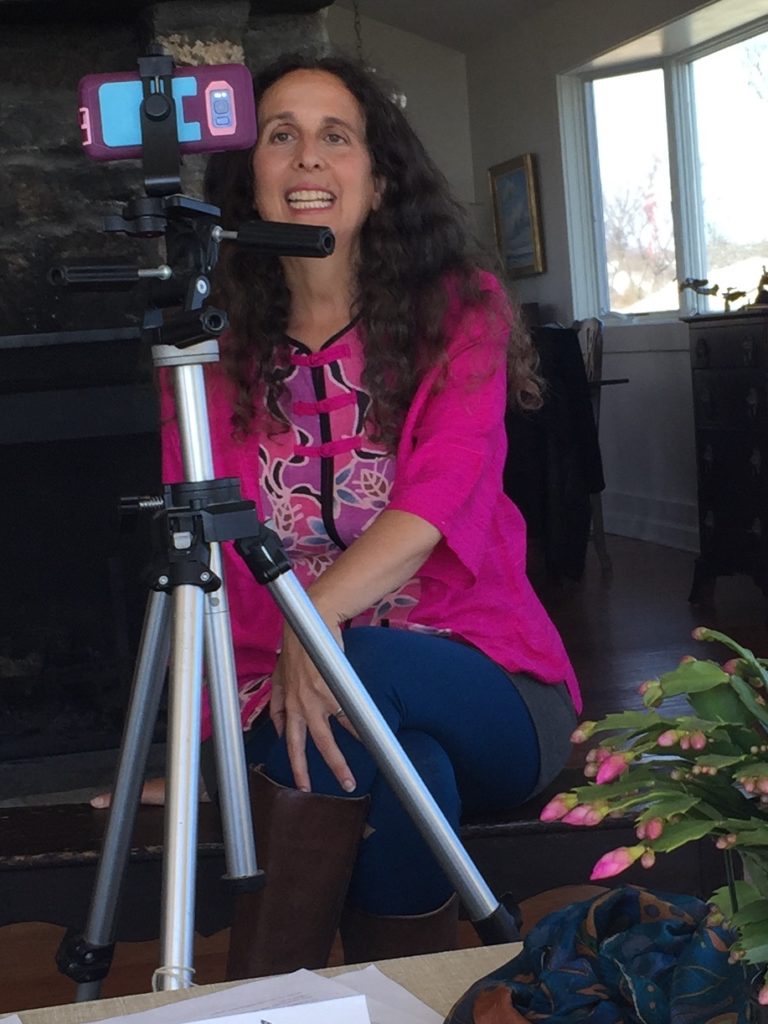
One exciting feature of my forthcoming book is that it will include QR codes that you can scan with your phone to watch a video or enjoy a guided meditation before writing. I’m excited about how this format can engage readers in an experience and make the journal so much more than your typical journal.
As a 30-day program, this means recording over thirty inspiring videos. Yes, thirty!
Now that I’ve handed my manuscript over to my publisher, I’m working on those videos. There’s an art to creating a video that has impact. What I’ve realized after coming up with concepts for each video is that delivery is everything! Since this is a skill I’m still polishing, I did what I always do in such situations—look for an expert guide, mentor, guru, coach. In this case, my friend and colleague, Portland Helmich.
I met Portland when launching my first book, The Ultimate Guide to Transforming Anger. Portland produced a segment on WCVB-TV news in Boston about Anger-obics, the creative exercises my co-authors and I developed to help people transform the way they deal with anger. Later, Portland created a segment about Anger-obics for the Hallmark Channel.

When Portland left that position and later hosted her own national show, What’s The Alternative?, she had me on to demonstrate Anger-obics. When she guest hosted various talk shows, she invited me on again. And we’ve been good friends ever since—seeing each other through challenging times, buying matching garlic shredders at the Newport Flower Show, and going for walks or to the beach when she could get down to Rhode Island from her home in Massachusetts.
When I realized I could not shoot these videos alone, I called Portland and asked for her help. I’ve gotten way more than a video producer in Portland. I’ve received excellent advice on what to wear, how to do my makeup, and how to pick a spot to shoot.
Even more powerful, as we shot each video, Portland helped me get clearer on the intention and message of each video, so that it would have the most value to viewers. She helped me practice and relax so that my best self came forth, rather than the insecure, script-memorizing goofball who sometimes took over.
But let’s back up here a couple of weeks. Days before our first video shoot, I got an email from my publicist at Pitch PR inviting me to be interviewed for HLN’s Weekend Express with Susan Hendricks, and to share 8 creative mood boosting tips. As much as I prepared my tips, I knew something was missing. Plus, my office was a mess and the screen I had ordered for my background was cancelled by the manufacturer when they ran out of supplies!
Instead of filming our inspiring videos, Portland ended up helping me clean and organize my office and make it an inviting space for my remote video interview. She removed some of the books in the corner bookshelf behind me and varied the piles—some standing up and some horizontal. She created space. It looked beautiful! This kind of attention to detail helped make my background inviting, personal, and yet allowed it to stay in the background and not distract the viewer.
(Note: Portland is part of my very small pod.)
Portland Helmich’s Tips for Creating the Best Video Background
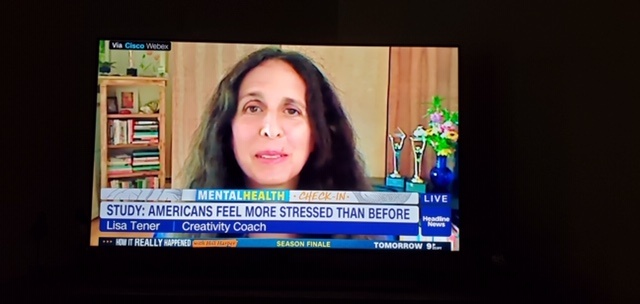
- Choose a space that’s professional, attractive, and neat. It shouldn’t be filled floor to ceiling with artwork, trinkets, and books. Some are fine, but too much stuff in view takes away from your message. For a TV interview, you likely don’t want to be interviewed in a nondescript space. You want your background to say something about you. If you’re a lawyer, you may have books behind you. If you’re a gardener, you may have plants. Just don’t overdo it.
- Tidy up. A cluttered space reflects poorly on you.
- Don’t sit with your bed in view. It looks unprofessional.
- Make sure there’s space behind you when you’re in front of computer. Make sure there’s depth, something for the eye to see beyond. Don’t sit with your back right to a wall.
- Position natural light in front of or beside you if possible. If not, place a lamp behind your computer so it shines evenly across your face.
- Avoid backlighting. That is, don’t sit with light shining from behind you, as you’ll appear in shadow on screen.
Portland also shared tips for wardrobe, jewelry, hair and makeup.
Portland’s Tips for Video and TV Wardrobe: What to Wear on TV
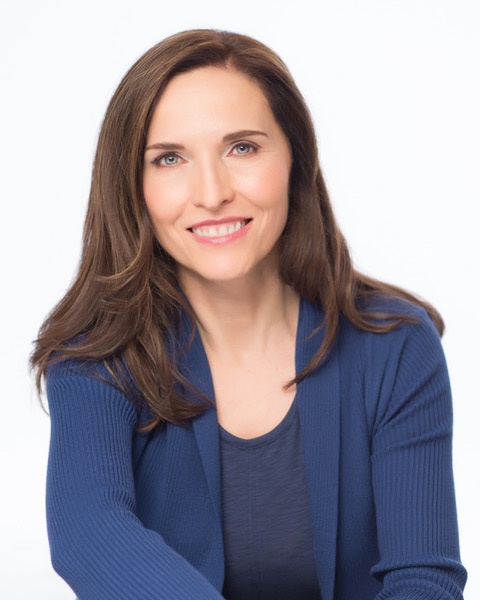
- As for clothing, you really only have to worry about your top for a TV interview. Stay away from white or very pale colors that can appear white. They reflect all the light. Conversely, black isn’t the best choice, either, as it absorbs light and can make your body kind of disappear. Choose a colored top that looks good on you.
- Stay away from busy prints like paisley, polka dots or pin stripes. They tend to moray on camera. (They can look like they’re moving). Choose a solid color instead (you can accent with a patterned scarf or tie as long as the print isn’t too distracting).
- Wear a jacket if you’re a man and it feels appropriate. You’ll look well put-together. If not, wear an ironed shirt.
- Stay away from shirts with visible logos or messages.
- Choose fitted jackets, blouses, sweaters and shirts over baggy ones. Loose and baggy clothing tends to make you look heavier on camera.
Portland’s Tips for Video and TV-friendly Jewelry
- Keep it simple. You want people looking at your face, not your jewelry.
- No long, dangling earrings–too distracting. Small hoops or studs are better.
- A simple chain necklace is fine, but nothing overly gaudy. In fact, you may choose to wear either a necklace or earrings, but not both (unless they’re understated).
- Ditch bracelets that clank, especially if you’re sitting in front of a desk that your wrists might accidentally whack. The sound can be super-distracting.
Portland’s Hair Tips for Video and TV
- Make it presentable. Comb it! If you can get it professionally cut and styled before your interview, all the better.
- Use a frizz-control hair product to tame fly-aways. (Portland had me use Moroccan Oil, which worked great!)
- Cover or color grays (if your hair is already colored and your roots are showing).
Portland’s Tips for Makeup That Makes Your Look Your Best on Video and TV
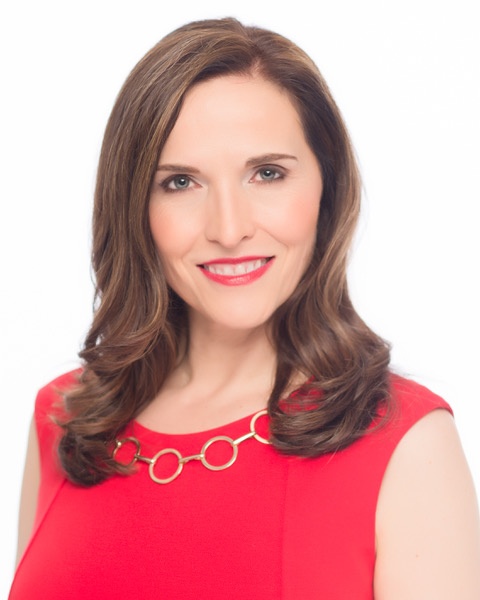
- Like with jewelry, keep it simple. You want people to look at you and not your makeup.
- Don’t make the mistake of going “au naturel,” however. Even a man can benefit from some translucent face powder, at the least, to soften the shine on his nose or the bald spot on his head.
- Wear some kind of tinted moisturizer or natural-looking foundation for even coverage (men can benefit from this, too).
- Use a lighter-than-your-skin-tone concealer under the eyes. Putting some in the corners of your eyes (near the bridge of your nose) can make them pop or appear larger.
- Apply a touch of blush on the apples of your cheeks (the part of your cheeks that plumps up when you smile).
- If you do wear eye shadow, stick with neutral tones. Stay away from brightly colored shades.
- Mascara is a good idea for TV. It enhances your eyes, outlining them. Same with eyeliner, but go easy on it.
- Shape and trim your eyebrows with scissors and/or a tweezer if they’re a bushy mess. If you’re older and your brows are faint, lightly color them in, but go easy on it.
- Color your lips with a neutral lip pencil—it’ll make lipstick last longer. Subtle colors are best. Dab a bit of gloss in the center of your lower lip only. Generally speaking, if you do choose a brighter lip color (like red), go easy on the eye makeup. If your eyes are more made up, choose a more neutral lip color.
- Finish it off with some powder to remove shine.
- If you have no clue how to do your own makeup, consider having it professionally done (or ask a skilled friend to do it for you).
Preparing for the TV Interview
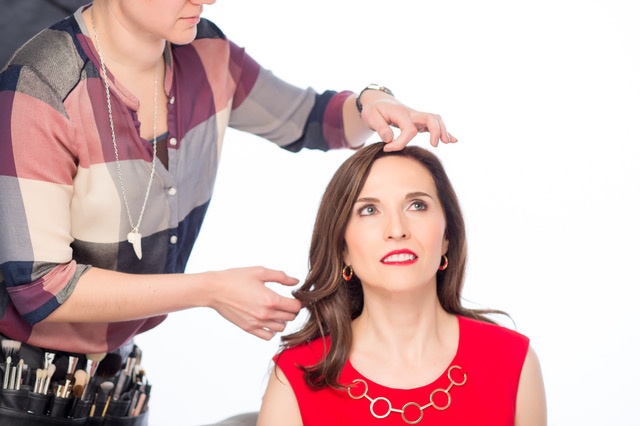
And then we practiced for the interview. Interviews have changed significantly from the time I launched my first book. Today, they are mostly on zoom or similar platforms. They tend to be much shorter. And the host often leads you through each tip, since they have them ahead of time.
One thing is absolutely the same: The more relaxed and comfortable you are, the more fun you have, the more inspired viewers will be, and the more impact you’ll have.
In addition to helping me relax, Portland gave me several great tips that helped make the interview engaging, fun and special. While I wasn’t able to use all of the tips on the shorter interview for HLN, I incorporated what I could. My longer interview with anchor Frank Mallicoat of KTVU, San Francisco, enabled me to use many more of her fun tips!
- Be playful: When I advised humming, Portland suggested I follow the first sentence by humming myself! Not only was it fun and playful, but the humming put me more at ease.
- Provide instruction: It’s one thing to say that research shows that humming relaxes you and helps you sleep. But if you provide specific instruction, viewers can actually practice right then and there. Portland said, “How about: You can hum a single tone, like this: Hmmmmm, or hum a tune, like this, hmm, hmm, mmmm, hmmm.”
- Demonstrate when you can, adapting for the medium: When it comes to the power of movement to relax and boost mood, I shared my favorite qigong practice—qigong bouncing. Portland had me demonstrate while sitting, to avoid the disruption of adjusting and readjusting my camera.
- Use props: When I spoke about using the sense of smell to boost mood and relax, Portland invited me to smell something. I opened a small bottle of essential oil and sniffed. Not only was it fun and engaging but the smell of the rose oil truly put me in a joyous state, something that was conveyed on screen.
- Give specific examples: As a specific example I suggested clary sage to calm the mind, citrus which energizes or lavender which uplifts.
Portland’s TV Interview Tips
Preparation
- Prepare for your interview. Practice answering the questions you’re likely to be asked with a friend or colleague. Work on keeping your answers to somewhere between 20 and 45 seconds. Don’t go over a minute answering a question if you can help it. (The average news soundbite is only nine seconds long).
- Have a clear sense of your message and trim it down to one to three main points. There won’t be time to say everything you want to say, so work on being succinct.
- Practice avoiding fillers, such as “um,” “uh,” “like,” and “you know.”
- Enunciate. Don’t speak so fast that people can’t understand you.
- Record yourself being interviewed on your phone in advance of the real deal. Watch yourself. Do you unconsciously cock your head to one side or another? Do you have a facial tic that needs reigning in? If you watch yourself, you have time to course-correct before the big day.
- Clear time in your schedule so you’re not rushing to get ready for the interview day of.
- Get into a good head space before “show time.” Meditate. Do some deep breathing or yoga. If you feel relaxed, you’ll perform better.
- Remove all distractions from your environment before the interview. Turn off your TV and cell phone. Put your kids and pets in a separate room where they can neither be seen nor heard.
During the TV Interview
- During the interview, make sure to look into the camera on your computer and not at the image of the person interviewing you, as counterintuitive as that is. (You might just be listening to the interviewer vs. looking right at him or her). If you look into the camera, it’ll look like you’re looking right at the host.
- Frame yourself in the camera so viewers can see your head down to just below your shoulders. Don’t put the very top of your head at the very top of the screen. Put a little space, or head room, between you and the top of the screen.
- When the interviewer is speaking, listen to the questions you’re being asked. Try as best you can to answer the question you’re asked rather than go off on tangents.
- Smile, even slightly, when you’re introduced and when you’re thanked at the end. You may still be visible if you’re on a split screen, so it’s worth it to smile occasionally during the interview, too, even when the interviewer is speaking (unless, of course, you’re speaking about something grim).
- Be yourself. When you’re authentic, viewers are much more likely to pay attention to what you have to say.
Portland’s Steps for How to Make Inspiring Videos
Just like when you write a story, you need a beginning, a middle, and an end.

- Communicate to viewers at the top what this video is about and how it’s going to help them.
- Get clear on your message. What’s the one thing you most want to communicate? Everything you say in your video should support that one central message. For example, when Lisa and I were working on a video about how travel can spark creativity, she began telling a story about a trip to Thailand. Her main point was simply that our five senses are stimulated in new surroundings, providing great fodder for creative writing. While rehearsing, she began telling a story about a ride with a cab driver to view ancient ruins and beautiful temples, but the story was superfluous. We quickly cut it and kept the focus on her main message—the way travel can spark our creativity.
- Offer examples that support what you’re saying. Video is obviously a visual medium. Take advantage of it, if you can. Include photographs or b-roll (footage that covers what you’re saying, which necessitates editing) or you could even hold up photos or objects. As well, don’t be afraid to move your body (as long as you don’t move out of frame) to help express what you want to say. You might hold up your fingers to illustrate, “Reason number one, reason number two,” and so on.
- Leave viewers with a positive feeling at the close of your video or encourage them to take inspired action. You might close with tips they can incorporate into their own lives.
- Finally, remember to smile!
Hiring a Media Coach to Prepare for Your TV Interviews (or Videos)
Being an inspiring guest, or shooting inspiring video, takes time and practice. I feel so grateful to have a wise mentor to guide me along the way.
I don’t know what I would have done without Portland’s feedback on my practice interviews and TV appearances, as well as her guidance in working through the videos for the book. If you are looking for an expert to coach you through media interviews or speaking on video, my friend Portland is available and you can reach her through her website portlandhelmich.com. Much of our mentoring and practice occurred over Zoom and she can do the same with you.
If you have questions for Portland, please leave them as a comment below and she’ll be happy to answer.
Update and More Tips for Audio and Video Recording for Authors
It’s a couple years later and you’ll never guess whom I hired to produce the videos for the next book! Okay, you’ll probably guess. Portland Helmich produced our videos and Dan Thibeault shot the videos, edited, added music, intro/outro, graphics and so much more! Dan also gave me some additional audio training and produced the ten or so audio recordings — meditations, visulaizations and breathing practices–for my upcoming book.
You can read all the new tips I learned from Portland and Dan about recording audio and video here.

